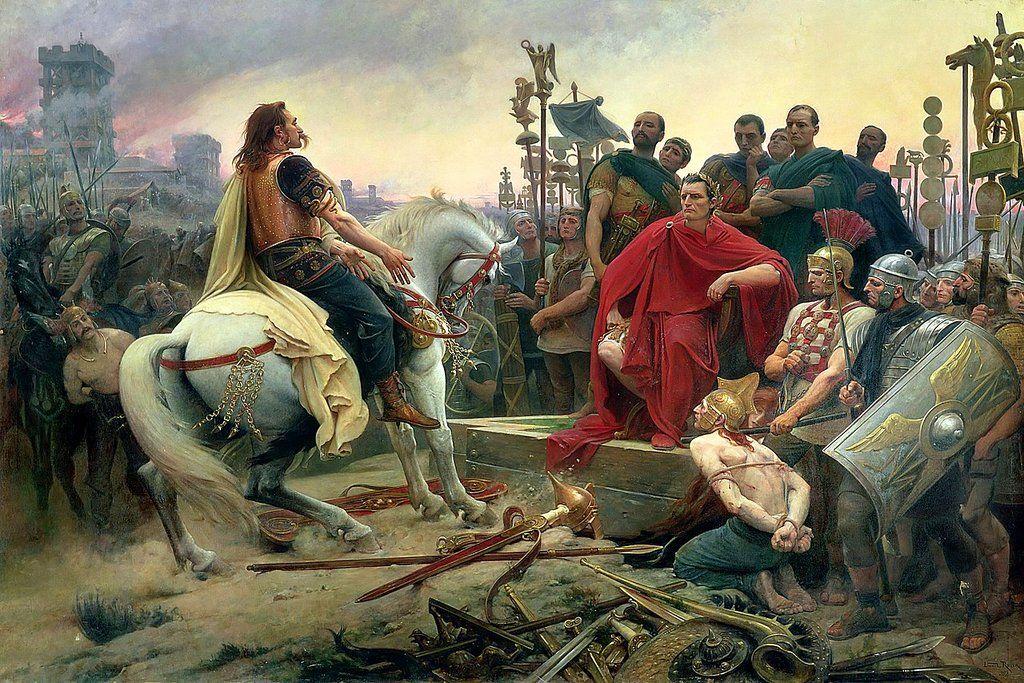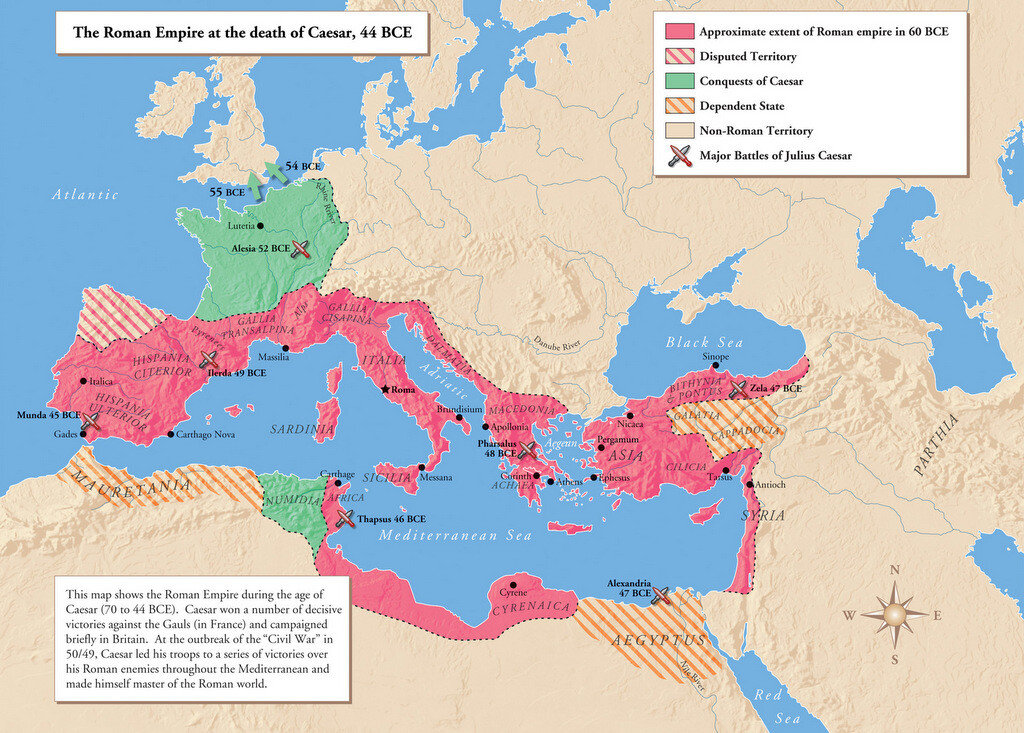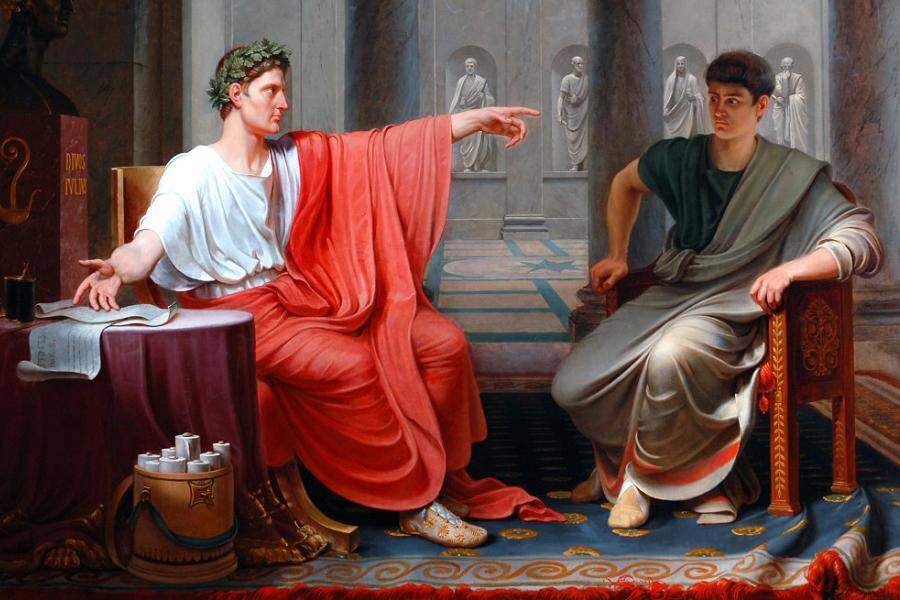The map of the Roman Empire shows us how Rome, an Italian city-state, spread throughout the Mediterranean. Evolving from a Republic to an Empire, Rome experienced its peak and then split into East and West.
In this article you can find a summary of the history of the Roman Empire. Afterwards, Rome was divided into East and West, and its legacy survived for another 1000 years thanks to the Byzantine Empire.
Roman Empire History and Map
The history of the Roman Empire is basically divided into two parts. The first of these is the Republic period, the second is the Empire period. Of course, the transition from republic to empire was not easy. In this article, I will try to explain each period with the help of Roman Empire maps and images.
Rome gained its early success as a Republic. It was ruled by the elites in the Roman Senate. In threatening situations, presidents were appointed under the name of Consul and they went on expedition at the head of the armies.
The army of the Rome was far superior to its rivals in terms of technique and discipline. These units, called the Roman Legions, were obliged to protect Rome surrounded by barbarian tribes and to conquer when necessary.
The consuls appointed by the Roman senate played a role in solving major problems. These included stopping Hannibal‘s invading armies, suppressing the Spartacus rebellion, and defeating Mithridates VI in the East.
However, there was always the possibility that consuls, equipped with extraordinary powers in wartime, could seize power in Rome. We see this risk peaking in the time of Julius Caesar. The period when the most powerful people of Rome unite against Caesar is the most interesting part of Roman history.
1. Julius Caesar

Julius Caesar was the most interesting character in Roman history. When Crassus, Pompei and Caesar formed the First Triumvirate, Julius Caesar prevailed with his intelligence and military skills. He conquered Gaul and neutralized the barbarians, then marched on Britain. He had a strong bond with his soldiers and the Roman legions literally worshiped him.
The other two people in the trio, the Pompei Magnus and Crassus, were also very dominant characters. It was already clear that the three lions would not stay in the same cage. Pompei and Crassus united to defeat Caesar, but failed.
The senate was uncomfortable that Julius Caesar became an extraordinary power. Moreover, Caesar allied himself with Egypt as a result of his marriage with Cleopatra.
A leader who seemed impossible to be defeated by war was assassinated in the senate. Caesar’s right-hand man Marcus Antonius and his adopted son Octavian swore revenge. The senators Brutus and Longinus, who organized the assassination, were put on the target board.
Roman Empire Map under Julius Caesar

The Julius Caesar era was the period when Rome made great conquests in Africa and central Europe. You can see these achievements on the map of the Roman Empire under Julius Caesar, marked in green.
Second Triumvirate
After the First Triumvirate ended in war, the second was established. The alliance included Octavian (the future emperor Augustus), Mark Antony, and Lepidus.
It was the revenge of Julius Caesar that was the driving force of the alliance. The assassins fled and assembled an army. However, they were defeated by the new consuls.
After Caesar’s revenge was taken, the three consuls began to deal with each other. Mark Antony, who allied himself with Cleopatra, was defeated by Octavian. The victorious Octavian proclaimed himself Roman Emperor with the name “Augustus”.
2. Emperor Augustus

Augustus did what the senate had expected from his father and proclaimed himself emperor. The era of Emperor Augustus and his right-hand man Agrippa brought great prosperity to Rome.
Rome ruled over much of the known world for the next 200 years. All the fertile lands and maritime trade in and around the Mediterranean were under Roman control.
Thanks to this, Roman engineering spread from one end of Europe to the other. Most of the Roman ancient cities in Europe, North Africa, and the Middle East today bear traces of this prosperous period.
Roman Empire Map under Augustus

By the time Emperor Augustus died, Rome dominated all the seas of trade. You can examine the dark parts on the map of the Roman Empire under Augustus.
Augustus’ rule witnessed great developments in world history. Especially the death of Jesus and the spread of Christianity by the apostles would mark Roman history.
Although the power of this new teaching was initially ignored, it later spread throughout Rome. Much has changed in the 300 years from Augustus to Constantine the Great.
3. Five Good Emperors
Rome reached its peak in the 1st and 2nd centuries AD. this era is described by historians as the period of the Five Good Emperors. These emperors were Nerva, Trajan, Hadrian, Antoninus Pius and Marcus Aurelius. During these emperors, the greatest extent of the Roman Empire were reached.
The peak, however, was also the beginning of the decline. The most prominent feature of the Five Good Emperors was that the emperors adopted and prepared the next ruler.
But Marcus Aurelius insisted on taking his own son to the throne instead of raising a gifted man. Commodus, who did not have the characteristics to become a strong leader, ascended to the throne and paved the way for decline.
The end of the Five Good Emperors has been the subject of many movies and TV series. Examples of these were featured in the movie Gladiator and in Netflix’s documentary-series Roman Empire: Reign of Blood.
4. Roman Empire Map at Its Peak

Roman Empire Map at Its Peak shows us military success unseen in world history. Although conquerors such as Alexander the Great and Genghis Khan established such great empires, none left such a legacy in world history as Rome.
Rome created a magnificent formula by adding military, architectural and administrative principles to the philosophy, mathematics and medical knowledge inherited from Ancient Greece.
However, like any great civilization, the Roman Empire declined after some point. This collapse spread over the centuries, leaving behind an heir like the Byzantine Empire.
50 Years of Chaos
The first signs of the decline were with Commodus’ ascension to the throne. During the Severan Dynasty, the deterioration was temporarily halted. Then Roman Empire entered a 50-year period of chaos.
Between 235 and 285 there was a period of great turmoil. The Emperors were deposed one after another and a new one came. The generals that ruled the Roman army were destroying the empire through the fights for the throne. It was Diocletian who put an end to this situation.
5. Map of Roman Tetrarchy

Diocletian made military, economic and political reforms and saved the empire from extinction. Then he introduced a new administrative system called Tetrarchy. As you can see in the Map of Roman Tetrarchy above, the empire was divided into four parts. However, not every ruler had equal authority.
The empire was basically ruled by two Augustus (senior emperors). These were Maximian and Diocletian. However, two more young emperors were appointed to lead the expeditions that would last for years. These people who became the Caesars (junior emperors) were Constantius (father of Constantine the Great) and Galerius.
However the system he established was against human nature. The peaceful sharing of political power between the four emperors was not possible in the long run. Constantine, one of the Caesars who gained power after Diocletian, destroyed his rivals and took power alone.
6. Foundation of Constantinople

During the reign of Emperor Constantine, the Roman Empire moved its center from Rome to Byzantium. Constantine grasped the strategic importance of Byzantium in the Tetrarchy era civil war and considered it as the new capital. The foundation of Constantinople lasted 6 years between 324 and 330, and it became the Roman capital with a grand ceremony.
Constantine’s new city offered better opportunities than the ancient capital Rome, which had lost its strategic importance. Because it was close to the two fronts that emperors had to fight. Roman Emperors had to fight against the Germanic Peoples in the West and the Sassanid Empire (Persians) in the East.
7. Division of the Roman Empire

After Constantine, the empire began to decline. Emperor Theodosius ascended the throne at a time when the empire was about to collapse. He won important military victories and secured borders. But he died unexpectedly in his 40s. With the death of Theodosius, the division of the Roman Empire became permanent.
Western Rome was left to Theodosius’s 12-year-old son Honorius, while Eastern Rome was left to 18-year-old Arcadius. With each emperor, there were experienced statesmen as regent.
8. Fall of the Western Roman Empire

However, Stilicho, the regent of Western Rome, had a short life. Stilicho, unwanted by the Senate, was declared a traitor and killed by a conspiracy. This paved the way for the fall of the Western Roman Empire.
Western Rome could only survive for 81 years after the division of Rome due to mismanagement. However, the Eastern Roman Empire, which we call the Byzantine Empire in modern history, survived until 1453.
9. Map of the Eastern Roman Empire

As shown on the map of the Eastern Roman Empire, it consisted of the Greek-speaking eastern states of Rome. Therefore, the rulers of the Eastern Rome became Helenized in time.
The transition from the Latin culture to the Greek culture began during the reign of Constantine and was completed during the reign of the emperor Heraclius. To give a rough history, all titles left from ancient Rome were abandoned in 300 years.
As the culture that developed in the Eastern Roman Empire over time was different from the ancient Rome, today’s historians define Eastern Rome as the Byzantine Empire. Its purpose is to distinguish between Latin-speaking Pagan Rome of antiquity and Greek-speaking Christian Rome of middle ages.
The Byzantine Empire blended the information it took over from the Roman Empire with the ancient Greek heritage and found a driving force that would last for hundreds of years.
Conclusion
It might be surprising to see such a passionate post about the Roman Empire on a blog about Istanbul. However, since Istanbul was declared the co-capital of Rome under the name of Constantinople after 330, this subject arouses my curiosity.
The Roman Empire left a great legacy to the world in the political, architectural and legal fields. Reaching incredible borders during the imperial period, Rome finally split into east and west in 395.
As a tour guide in Istanbul, I see that my Western guests’ knowledge of the Roman Empire ended in 476. It should be emphasized, however, that after the collapse of Western Rome, the Roman legacy continued to live on in Eastern Rome (aka Byzantium).
The city where this culture lived was Constantinople, and the legal heirs of the Roman Empire were the Byzantine emperors. In fact, Rome had significant effects even in the Ottoman Empire after Byzantium.
Written by Serhat Engul
Leave a Reply